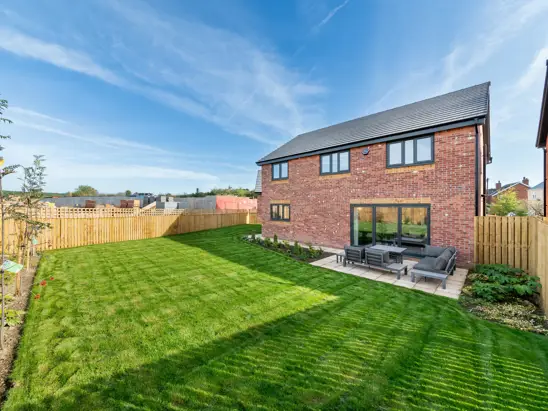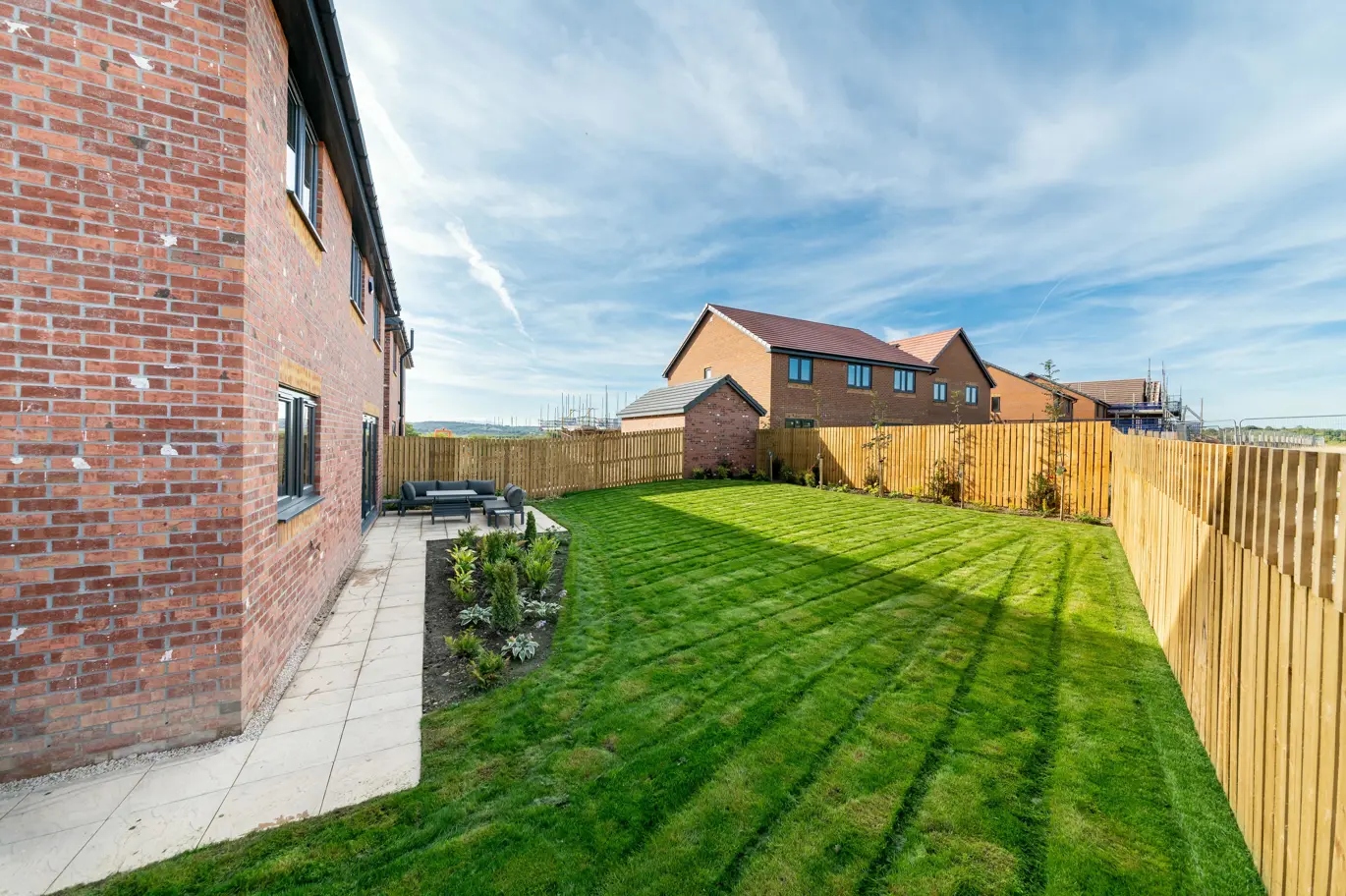Our top garden landscaping ideas to get your new build summer-ready
10 min read - by Redmile Homes
First of all, congratulations on your new home! Moving into a new build is an exciting milestone, and one of the best parts is the chance to put your personal stamp on every space – including the garden.
While your outdoor area might begin as a blank canvas, that’s exactly what makes it full of potential. With a little inspiration and creativity, you can turn it into the perfect spot for summer relaxing, entertaining, or family fun.
To help you get started, we’ve gathered some practical and stylish garden landscaping ideas and tips to help bring your garden to life this summer.

Where to begin with new build back gardens
Getting started with your new build garden doesn’t have to feel overwhelming. The best first step is simply to spend some time in the space – get a feel for how it works, gather ideas, and start picturing what you’d like it to become.
You can do this while taking care of your current lawn or turf, so that you’ve got a tidy, usable area to enjoy as you plan out the wider design.
1. Sunlight and shade
Take note of how sunlight moves through the garden at different times of day. Which areas get full sun in the morning or afternoon? Where are the natural shady spots? This will help you decide on the best places for seating, planting, or even a vegetable patch.
2. Soil type and drainage
Check the condition of your soil – feel its texture, check for compaction, and see how well it drains after rainfall. Your new build garden hasn’t had the chance to be cultivated or enriched yet, so the soil might need a little extra attention to get it just right for planting.
3. Layout and levels
Think about how you want to use the space. Would you like a patio for entertaining? A play area for children? Raised beds or flower borders? Sketching out a basic layout can help you visualise different zones and plan how people will move through the space.
4. Privacy and boundaries
Take a look at your fencing and garden edges. Would you like a bit more privacy from your neighbours? Think about where you could use trees, hedges, or climbing plants to define your space, add some greenery, and soften the appearance of fences and walls.
5. Utility access and future projects
If you’re thinking of adding features like a shed, lighting, an outdoor tap, or even a garden room further down the line, it’s worth factoring in where access points, power, and water lines might go. Planning ahead can help you save time and avoid having to dig things up later.
6. Budget and maintenance
Finally, consider how much time and budget you want to invest. There are plenty of attractive, low-maintenance ideas out there to suit all lifestyles. Plus, you don’t have to do everything at once – start with the essentials and build on your design over time.
New build garden ideas
Now that you’ve got a feel for your new build garden and a basic plan, it’s time to get creative. Here are some ideas to help you transform your space.
Adding hard landscaping
Laying out paths and patios is a fantastic way to kick-start your summer garden transformation. These features help define different zones within your garden, such as planting and seating areas, and give structure to the overall layout. Completing this step before adding greenery means you won’t risk damaging your new plants.
There are plenty of options to suit every garden style and budget. Curved paths are perfect for smaller gardens, creating a sense of flow and helping the space feel larger. For a more contemporary look, angular paths provide a clean, modern aesthetic. Cost-friendly materials like gravel, bark chippings, or reclaimed bricks can keep the price down while adding charm.
If your garden is on a slope, consider incorporating terraces or level changes. Not only does this improve access and usability, but it also adds depth and interest to your design. Just remember to plan for proper drainage to keep your hard landscaping looking good and performing well all year round.
Prepping your soil
Once your paths, stepping stones, and other hard landscaping is done, it’s time to turn your attention to the soil. New build gardens offer the unique opportunity to improve your soil from the start, giving your plants the best possible conditions to grow.
Begin by digging over any areas where you plan to plant or lay turf, breaking up the compacted ground to allow roots to penetrate more easily. Then, improve your soil by adding a conditioner, such as well-rotted manure or soil improver, to help enhance drainage and fertility.
If there are areas that you’re not going to plant immediately, consider covering them with bark mulch. This will help suppress weeds, conserve moisture, and maintain soil structure until you’re ready to start planting.
Picking your plants
It’s easy to get excited about filling a new build garden, but it’s best to start small. Each plant has its own care needs, and trying to manage too many at once can quickly become overwhelming. A great rule of thumb is to try 5–10 new plant species each season, so you can learn what thrives in your garden and build confidence as you go.
For beginners, cut flowers like sunflowers, zinnias, cosmos, cornflowers, and poppies are a fantastic choice. They’re easy to grow from seed, affordable, and bring vibrant colour all summer long. For quick blooms and low effort, try fast-growing, hardy plants like buddleias, lavender, and geraniums. These perennials are long-lasting, resilient, and great value for money.
Pots and window boxes are another simple way to add instant colour, especially around patios, entrances, or windows. Just remember that smaller containers dry out faster than larger garden beds, so they’ll need more regular watering.
Top Tip: Plant your cut flowers a little closer together than the seed packet suggests. This encourages them to grow taller with longer stems – perfect for filling vases indoors.
Growing your privacy
Looking for low-maintenance garden border ideas that also boost privacy? You don’t have to sacrifice style or greenery to keep things simple – a well-planned mix of trees, shrubs, and climbers can deliver quick results with minimal effort.
- Trees: Small trees like silver birch, rowan, and alder add height and character quickly, without overwhelming the space. They’re affordable when young, support local wildlife, and offer year-round interest with beautiful bark, blossoms, or berries.
- Shrubs: Evergreen plants like box, hebes, choisya, or photinia provide year-round structure and colour, and they only need occasional trimming to stay tidy. Pair these with hardy perennials or spring bulbs for seasonal vibrancy.
- Climbers: Honeysuckle, star jasmine, or clematis armandii work well on trellises or fences to soften hard boundaries and add floral accents. While they need a bit of tying in as they grow, most are low effort once established.
Top Tip: Focus on planting long-term features like trees, hedges, and climbers early on. They’ll quietly grow into place while you work on the rest of your garden – giving you privacy, shade, and a greener backdrop in no time.
Adding finishing touches
Once the essentials are in place, it’s time to add those final details that make your garden feel truly yours. A cosy seating area can make a huge difference to how much you enjoy your outdoor space. Accessorise with outdoor cushions, parasols, and rugs to bring colour and personality. Add lighting like lanterns or fairy lights to keep the space usable and atmospheric after sunset.
New build front garden ideas
We’ve covered the back garden, now let’s look at the front! Your front garden is the first impression of your new home, and even small updates can make a big difference:
- Use compact shrubs, hardy perennials, or ornamental grasses for low-maintenance planting
- Frame your doorway with pots of seasonal flowers for a welcoming touch
- Add gravel paths or stepping stones to keep things neat and tidy
- Decorate front boundaries with painted fences or solar lights
Remember: In most areas, front garden fences can’t exceed 1 metre without planning permission (2 metres for back gardens). Always check with your local council before making changes.
Yorkshire homes by Redmile, Yorkshire gardens by you
With a bit of care and creativity, even a brand-new plot can become a vibrant space for relaxing, entertaining, and making memories this summer.
Start simple, enjoy the process, and let your garden grow with you. And when you’re ready, we’d love to see what you’ve created – tag us in your garden transformation photos and share your journey with the Redmile community.
Follow Us:

Author: Redmile Homes
7/1/2025

Value for money and a home to be proud of.